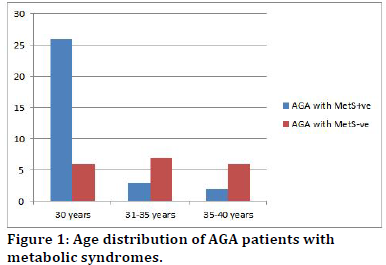Research - (2021) Volume 9, Issue 8
To Study the Association of Androgenetic Alopecia and Metabolic Syndromes in Male Population
*Correspondence: Asha D, Department of Dermatology Venereology and Leprosy, Sree Balaji Medical College & Hospital Affiliated to Bharath Institute of Higher Education and Research, India, Email:
Abstract
AGA was found to be common in 74% of patients in the age group of 30 years. In our study, most of the patients presented with a combination of Basic and Specific pattern. 66% of patients had M pattern, 52% had V pattern, 14% had U pattern, 14% had F pattern and 12% had C pattern The M pattern is found to be the commonest pattern and specifically the M 1 pattern with 28%. V 1 with 26% was the second most common pattern. U pattern was the commonest pattern with fasting blood sugar 2: 100 mg/dl (85.71%), followed by C pattern (83.33%), M pattern (69.70%), V pattern (69.23%) and F pattern (44.44%) 100% of U pattern AGA patients showed triglyceride values 2: 150 mg/dl, 66.67% in C pattern, 53.85% in V pattern, 51.52% in M pattern, and 33.33% in F pattern .results also confirms that AGA patients especially with U pattern are prone to developed insulin resistance.
Keywords
AGA, Insulin resistance, TriglycerideIntroduction
Androgenetic alopecia (AGA) is a syndrome causing hair loss in both male and female. Its associated with other diseases like hypertension, resistance to insulin, heart diseases, prostate cancer etc… It also increases the risk of developing cardiovascular diseases which can be even asymptomatic [1-3]. Hence it needs to be detected at the early stages. This Paper deals with the association of Androgenetic alopecia and metabolic syndromes in group of male population.
Methodology
A cross sectional study on the association of androgenetic alopecia and metabolic syndromes includes 50 patients of age group 25-40 years who are clinically diagnosed as Androgenetic alopecia. Patients were subjected to general and dermatological examination and blood investigations.
Results
In our study, 50 male patients diagnosed with AGA were investigated for other conditions like hypertension, hyperlipdemia, insulin resistance and the various patterns of AGA according to the BASP classification. AGA was found to be common in 74% of patients in the age group of 30 years, 14% in the age group of 31-35 years and 12% in the age of 35-40 years. It was observed that 83.87% patients had metabolic syndrome in the age group of 30 years, 9.68% in the age group of 31-35 years, and 6.45% in the age group of 35-40 years. In our study, 85.71% patients with U pattern hair loss had metabolic syndrome. From our study, the commonest pattern of hair loss was M pattern but the commonest pattern associated with metabolic syndrome was the U pattern. Patients with U pattern are at risk of developing metabolic syndrome, and hence were thoroughly screened for metabolic syndrome and its complications. U pattern was the commonest pattern with fasting blood sugar 2: 100 mg/dl (85.71%), followed by C pattern (83.33%), M pattern (69.70%), V pattern (69.23%) and F pattern (44.44%) (Figure 1).
Figure 1: Age distribution of AGA patients with metabolic syndromes.
Discussion and Conclusion
AGA is the main cause of hair loss in men. It’s proved to be a genetic disorder wherein the hormone androgen plays a vital role in prognosis of AGA. Cotton et al. [4-9] first reported the association of hair loss and cardiovascular disease/ This study proves a strong association between early onset of AGA and metabolic syndrome and also it was confirmed that patients with U pattern of hair loss are at risk of developing metabolic syndrome in which 100% elevated triglyceride levels, high fasting blood glucose level at (85. 71%), low HDL level (85.71%) and also prone to developed insulin resistance.
References
- Thiboutat D, Bayne E, Thomas J, et al. Immunolocalization of 5a reductase isoenzymes 1n acne lesions and normal skin. Arch Dermatol 2000; 136:1125-29.
- Sawaya ME, Price VH. Different levels of 5alpha reductase type I and II, aromatase, and androgen receptor in hair follicles of women and men with androgenetic alopecia. J Invest Dermatol 1997; 109:296-300.
- Trueb RM. Is androgenetic alopecia a photo aggravated dermatosis? Dermatology 2003; 207:343-8.
- Cotton SG, Nixon JM, Carpenter RG, et al. Factors discriminating men with coronary heart disease from healthy controls. Br Heart J 1972; 34:458-64.
- Hibberts NA, Howell AE, Randall VA. Balding hair follicle dermal papilla cells contain higher levels of androgen receptors than those from non-balding scalp. J Endocrinol 19 98; 156:59-65.
- Fujimoto R, Morimoto I, Morita E, et al. Androgen rec ep to rs , 5 alpha-reductase activity and androgen-dependent proliferation of vascular smooth muscle cells. J Steroid Biochem Mol Biol 1994; 50:169-74.
- Sheridan PJ , McGill HC, Aufdemorte TB, et al. Heart contains receptors for dihydrotestosterone but not testosterone: Possible role in the sex differential in coronary heart disease. Anat Rec 1989; 223:414-9.
- Weyrich AS , Rejeski WJ , Brubaker PH, et al. The effect of testosterone on lipids and eicosanoids in cynomolgus monkey. Med Sci Sports Ex 1992; 24:333-8.
- Kavand S, Shahgholi L, et al. Androgenic alopecia and insulin resistance: Are they really related? Clin Exp Dermatol 2009; 34 :694- 7.
Author Info
Department of Dermatology Venereology and Leprosy, Sree Balaji Medical College & Hospital Affiliated to Bharath Institute of Higher Education and Research, Chennai, Tamil Nadu, IndiaCitation: Asha D, To Study the Association of Androgenetic Alopecia and Metabolic Syndromes in Male Population, J Res Med Dent Sci, 2021, 9(8): 55-56
Received: 14-Jul-2021 Accepted: 03-Aug-2021

